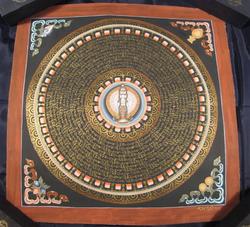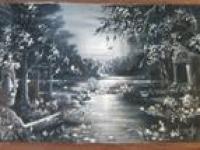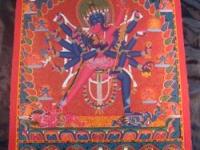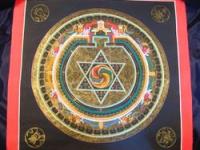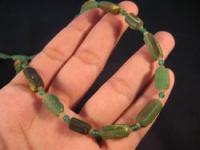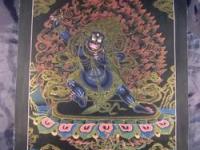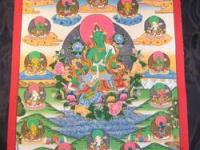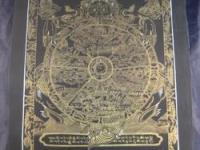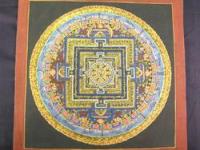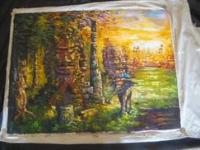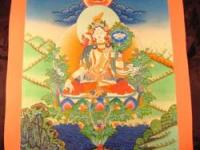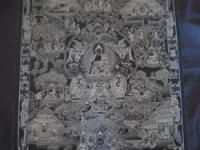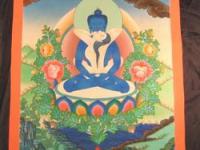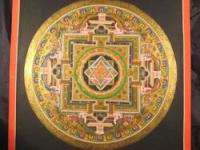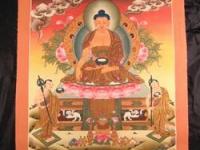This is a truly stunning Lokeshvara Thangka painting from Nepal. I brought it back with me from my last trip there. The detail is incredible and very precise. Real 24 K gold paint was used in its creation.
The figure is Sahasrabhuja Lokeshvara or 1000 arm god of compasion.
The basic form of this portrayal is the eleven-headed aspect of Avalokiteshvara, named Ekadashamukha. However, this form has an even more elaborate variation, with one thousand arms, instead of Ekadashamukha’s customary eight, and is therefore called Sahasrabhuja.
Nothing arises for no reason, and there is a plausible explanation for the eleven heads. By means of his immeasurable compassion and meditative muscle, Avalokiteshvara managed to empty the hells and ensure that there was potential salvation for everyone. Enthused, he reported this to his spiritual father, Amitabha, who told him to take a look behind himself. Almost instantly the underworlds began filling up again with new sinners who had not escaped from samsara. Sinking into despair, Avalokiteshvara wept so pitifully that his head burst. Amitabha attempted to assemble the pieces but did not entirely succeed. He supplemented the pieces to make nine complete faces, each with a gentle expression. Above this he placed the blue demonic head of Vajrapani that functions to ward off evil, and at the very top, for protection, his own head. Four of Sahasrabhuja’s eight main arms are identical to Shadakshari’s. His right hands are in varamudra, the gesture of granting favor, and hold the dharma chakra, the wheel of the teachings. Although this version is slightly different, normally his left hands hold a bow and arrow to symbolize keeping dangers and temptations at a distance, and a kalasha, or water jug, containing the nectar of immortality, amrita, which is a symbol of the deathlessness of nirvana. His 992 other arms are placed like an aureole around the bodhisattva. The idea of a thousand arms is comparable to that of the thousand buddhas: the more the mightier. The eye located in the palms of all the hands means that nobody escapes Avalokiteshvara’s great compassion.
The canvas is in great shape and I can see no real flaws in the artwork. I truly get a sence that the artist was fully comitted to doing an excellent job with this painting and did not rush his work. High quality all the way through. I know whoever gets this painting will be very happy with it.
Size: 15.8" tall and 15.8" wide ( 40.1 cm tall and 40.1 cm wide ) including border. 13.6" tall and 13.6" wide ( 34.5 cm tall and 34.5 cm wide ) excluding border.
The figure is Sahasrabhuja Lokeshvara or 1000 arm god of compasion.
The basic form of this portrayal is the eleven-headed aspect of Avalokiteshvara, named Ekadashamukha. However, this form has an even more elaborate variation, with one thousand arms, instead of Ekadashamukha’s customary eight, and is therefore called Sahasrabhuja.
Nothing arises for no reason, and there is a plausible explanation for the eleven heads. By means of his immeasurable compassion and meditative muscle, Avalokiteshvara managed to empty the hells and ensure that there was potential salvation for everyone. Enthused, he reported this to his spiritual father, Amitabha, who told him to take a look behind himself. Almost instantly the underworlds began filling up again with new sinners who had not escaped from samsara. Sinking into despair, Avalokiteshvara wept so pitifully that his head burst. Amitabha attempted to assemble the pieces but did not entirely succeed. He supplemented the pieces to make nine complete faces, each with a gentle expression. Above this he placed the blue demonic head of Vajrapani that functions to ward off evil, and at the very top, for protection, his own head. Four of Sahasrabhuja’s eight main arms are identical to Shadakshari’s. His right hands are in varamudra, the gesture of granting favor, and hold the dharma chakra, the wheel of the teachings. Although this version is slightly different, normally his left hands hold a bow and arrow to symbolize keeping dangers and temptations at a distance, and a kalasha, or water jug, containing the nectar of immortality, amrita, which is a symbol of the deathlessness of nirvana. His 992 other arms are placed like an aureole around the bodhisattva. The idea of a thousand arms is comparable to that of the thousand buddhas: the more the mightier. The eye located in the palms of all the hands means that nobody escapes Avalokiteshvara’s great compassion.
The canvas is in great shape and I can see no real flaws in the artwork. I truly get a sence that the artist was fully comitted to doing an excellent job with this painting and did not rush his work. High quality all the way through. I know whoever gets this painting will be very happy with it.
Size: 15.8" tall and 15.8" wide ( 40.1 cm tall and 40.1 cm wide ) including border. 13.6" tall and 13.6" wide ( 34.5 cm tall and 34.5 cm wide ) excluding border.
Payment Methods


Shipping
FREE Shipping
Please Login or Register first before asking a question.
